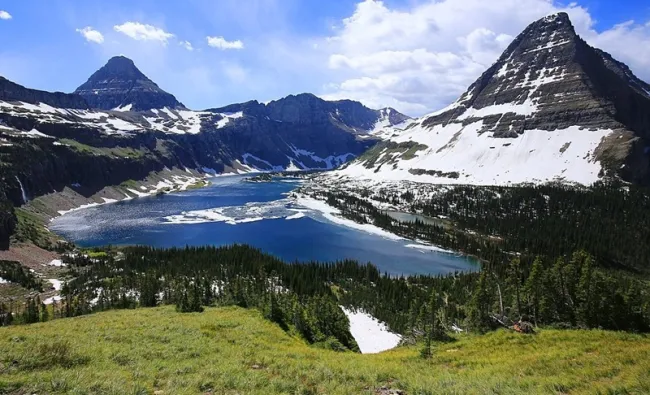
Glacier National Park, often referred to as the "Crown of the Continent," is located in the northern Rocky Mountains of Montana. Known for its stunning landscapes of rugged mountains, pristine lakes, and diverse wildlife, the park offers a gateway to some of the most untouched natural beauty in the United States. With over 1 million acres of wilderness, Glacier National Park is a haven for outdoor enthusiasts, attracting millions of visitors each year.
History of the Park
Glacier National Park was established in 1910, making it one of the oldest national parks in the United States. The park's name derives from the remnants of glaciers that carved the valleys and shaped the landscape over millennia. The area has a rich history, having been inhabited by Native American tribes for thousands of years. The Blackfeet and Salish peoples considered the land sacred, and traces of their history can still be seen throughout the park. In 1932, Glacier National Park and Canada's Waterton Lakes National Park were designated the world's first International Peace Park, symbolizing the goodwill between the two nations.
Main Features
Glacier National Park is home to over 130 named lakes, more than 1,000 different species of plants, and hundreds of animal species, including grizzly bears, mountain goats, and bighorn sheep. Some of the park's most notable features include:
- Going-to-the-Sun Road: A 50-mile engineering marvel that cuts through the heart of the park, offering breathtaking views of mountains, glaciers, and lakes.
- Lake McDonald: The largest lake in the park, offering opportunities for boating, fishing, and relaxing along its shores.
- Many Glacier: Known as the "Switzerland of North America," this area features towering peaks, deep valleys, and numerous glaciers.
- Grinnell Glacier: One of the most accessible glaciers in the park, offering a challenging hike with rewarding views.
Types of Trails
Glacier National Park offers more than 700 miles of trails, catering to all levels of hikers. Some popular trail types include:
- Easy Trails: Suitable for families and beginners, trails like the Trail of the Cedars and the Hidden Lake Overlook offer scenic views without too much elevation gain.
- Moderate Trails: Trails like Avalanche Lake and Grinnell Glacier offer a bit more challenge but are still accessible for most hikers.
- Strenuous Trails: For the more experienced hiker, routes like the Highline Trail and the Ptarmigan Tunnel Trail provide adventure with steep climbs and breathtaking vistas.
Crowd Expectations and Annual Visitors
Glacier National Park sees over 3 million visitors annually, with peak visitation occurring in July and August. The park can become crowded during the summer months, especially around popular areas like the Going-to-the-Sun Road and Many Glacier. To avoid crowds, it's best to visit during the shoulder seasons in late spring or early fall.
Accessibility for Seniors and Wheelchairs
Glacier National Park is committed to providing access for all visitors. Some key areas and facilities have been designed with accessibility in mind:
- Accessible Trails: The Trail of the Cedars and parts of the Apgar Visitor Center are wheelchair accessible.
- Visitor Centers: Facilities like the Logan Pass Visitor Center and St. Mary Visitor Center offer accessible restrooms, exhibits, and parking.
- Shuttle Services: The park offers a free shuttle service along the Going-to-the-Sun Road, which is accessible for visitors with mobility challenges.
Park Amenities
Glacier National Park offers a variety of amenities to make your visit comfortable and enjoyable:
- Visitor Centers: Several visitor centers throughout the park provide information, maps, restrooms, and ranger-led programs.
- Dining: Lodges such as Many Glacier Hotel and Lake McDonald Lodge offer dining options ranging from casual to more upscale.
- Gift Shops: Located in many of the park's lodges, these shops offer souvenirs, clothing, and outdoor gear.
Camping Facilities
The park offers 13 campgrounds with over 1,000 campsites. Campgrounds range from primitive to those with modern amenities such as running water and flush toilets. Reservations are highly recommended for popular campgrounds such as Many Glacier and Fish Creek, especially during peak season. Backcountry camping is also available with a permit for those looking for a more remote experience.
Access to Lodging
There are several lodging options within Glacier National Park, including historic lodges, motor inns, and cabins. Some of the most popular include:
- Many Glacier Hotel: Nestled along the shores of Swiftcurrent Lake, this grand lodge offers stunning views and classic charm.
- Lake McDonald Lodge: A Swiss chalet-style lodge located on the shores of Lake McDonald, offering a cozy retreat.
- Rising Sun Motor Inn: Located along the Going-to-the-Sun Road, this inn offers easy access to popular park attractions.
Pet-Friendliness
While Glacier National Park allows pets in certain areas, it's important to note that pets are not permitted on trails, in the backcountry, or in any park buildings. Pets are allowed in developed areas such as campgrounds, parking areas, and along roads. It's essential to keep pets on a leash at all times and never leave them unattended.
Best Months to Visit
The best months to visit Glacier National Park are from late June to mid-September when the Going-to-the-Sun Road is fully open and the weather is ideal for hiking and outdoor activities. July and August offer the warmest temperatures and the most accessible trails. However, for those seeking fewer crowds and cooler temperatures, late September can be an excellent time to visit as fall foliage begins to emerge.
Conclusion
Glacier National Park is a majestic destination that offers something for everyone, from scenic drives and easy hikes to challenging backcountry adventures. Whether you're seeking solitude in nature, stunning mountain views, or wildlife encounters, Glacier National Park delivers an unforgettable experience. With its rich history, diverse ecosystems, and commitment to accessibility, the park is a true gem of the national park system. Visiting during the right time of year and planning ahead can help ensure a memorable and enjoyable trip to this remarkable wilderness.



